Y-12 Blog

A political science major at UT, Asya H. is gaining knowledge about nuclear safeguards during her internship.
Asya H. comes from a family of engineers.
Her father, Ali, is a civil engineer and assistant director with Tennessee Department of Transportation; her brother, Arda, graduated in the spring with a mechanical engineering degree from the University of Tennessee in Knoxville. So, it seems she is a natural for the CNS Summer Internship Program.
However, Asya didn’t follow in her family’s footsteps and engineered a different path to her internship and arrived a UT political science major.
“My dad is a math whiz,” she said. “He can solve calculus problems in his head. All that math and science goes over my head.”
The rising senior is among 51 CNS interns, who hail from 13 states and 25 colleges. Y‑12 boasts 36 interns, while Pantex hosts 15. With an almost 50 50 split among male and female participants, the majority of interns, 33, are engineering majors, followed by computer science degree seekers.
“The intern program is definitely growing,” said Cristy Landrum, a human resources recruiter at Y‑12. “We had 40 interns last summer. We’re excited to welcome the interns onboard.”
The program began June 7 and offers specialized professional development training, which enhances communication networking, career goal setting, and professionalism. Each intern has a defined work scope and a summer project, which will be showcased at an expo August 10. The program ends August 12.
In summer 2020, the program went virtual because of the COVID‑19 pandemic. This year students have the choice of onsite, remote, and hybrid participation.
The lone political science major (with emphasis on international affairs) in the program, Aysa is going the hybrid route, spending a couple of days on site at Y‑12. Her goal is to become a lawyer and specialize in international nuclear law.
“It’s a very niche kind of field,” she said. “I have a lot to learn. I’m reading lots of legal documents,” which she is doing under the guidance of internship mentor Hannah Hale, a program manager within Global Security and Strategic Partnerships at Y‑12.
This summer, Aysa is primarily working with NNSA’s NA 241, Office of International Nuclear Safeguards. Within the office, she supports NA 241’s International Nuclear Safeguards Engagement Program — whose mission is to work with partners from around the world as they adopt and implement international nuclear safeguards agreements — a pivotal part of the nuclear non nonproliferation regime. For her summer project, she will participate in and support a virtual workshop about import and export reporting requirements under a safeguards agreement with 13 Middle Eastern states.

Kennedy V. is focusing on explosives technology at her third summer stint at Pantex.
A great introduction
As a three‑time intern at Pantex, Kennedy V. has gained a lot from the program.
“It has helped me develop my networking skills and grow as a scientist and engineer,” said the first year West Texas A&M University graduate student. “It’s been great. The hands on experience at West Texas A&M is limited, so coming to work in the Pantex laboratory, I was excited to gain more knowledge using the technology I learned so much about during my undergrad.”
This summer, Kennedy will examine things that go boom, but not really. She is an intern in Explosive Technology in High Explosives and Materials Testing.
“My project will involve the analysis of LM 17 mock composition, using a near infrared spectrometer,” she explained. “The mock material acts as a non‑energetic simulator for inclusion in test assemblies, where actual explosives would be hazardous or unnecessary.”
The composition of the mock explosive should react similarly to its real counterpart without detonation.
The process is only one stage of explosives testing, which has improved over time.
“Once developed, the near infrared technique should only take a couple hours to get composition results,” Kennedy said. “Newer methods have advanced this process to a few days, and there was even a time when it took multiple weeks.”
Kennedy, who also has an undergraduate professional chemistry degree, said “I love explosive technology. It’s a great introduction into the engineering world.”

Y‑12 intern Joshua W. holds the sensors used in the ChIMES (Chemical Identification by Magnetoelastic Sensing) Sensor Miniaturization project.
Keeping it current
Intern Joshua W., a senior at Texas Tech University, has returned for his second summer at Y‑12.
“It has been a really great time,” said the electrical engineering major. “The technology is crazy. You learn a lot of stuff in school, but to actually see it play out in a real application is so different.”
Last summer, Joshua’s project was ChIMES (Chemical Identification by Magnetoelastic Sensing) Sensor Miniaturization. The technology differentiates types of and amounts of chemicals present in a system. Chemicals can be sensed through metallic and nonmetallic barriers. When a sensor that is attached to a magnetic wire is exposed to chemicals, the tension applied to the wire changes. This change alters its magnetic properties. For the project, Joshua’s objective was to help transform the tabletop device into a more portable version.
For summer 2021, “It’s a new project, same device,” Joshua said. “There’s still a lot of work to do.” This time he will focus on the device’s sensors.
“I’m going to learn how to fabricate the sensors for target materials,” he explained.
Also, Joshua hopes to install a new circuit board on the device. He has worked on the board for months as a research at Texas Tech.
“I’m integrating the board with a system that’s already built,” he explained. “I’m implementing lab work with a real project. I built this thing and [I am] not sure if it will work on the real device.”
Joshua acknowledges that many hands and minds have touched the ChIMES project.
“There is a long line of interns who have been working on this,” he said. “I’ve just added some of my own flourishes.”

The Boys & Girls Clubs of the Tennessee Valley is one of many organizations that helps provide childcare services to families. By the Boys & Girls Clubs keeping its doors open during the pandemic, children were able to continue being children.
“CNS sought to help community organizations respond to critical needs throughout the pandemic by providing contributions rapidly and responsibly. An important step was directing CNS Community Investment Fund dollars to the East Tennessee Foundation’s Neighbor to Neighbor Fund. Together, CNS and the Foundation were able to quickly get much-needed resources to several nonprofit organizations in East Tennessee.
Keeping services available for children
In 2020, with COVID‑19 raging, the Boys & Girls Clubs of the Tennessee Valley vowed to keep the doors open and provide critical childcare services to as many children and families as possible. Using a $2,500 grant from the East Tennessee Foundation through the CNS Community Investment Fund, matched by another $2,500 from ETF’s Youth Endowment, the Boys & Girls Clubs were able to extend service hours at four club locations in Knox, Blount, Loudon, and Anderson counties. This extension provided extended childcare services at club locations for children of essential workers who had to work during the COVID‑19 crisis.
The Boys & Girls Clubs also provided daily take‑home boxed meal service for youth at clubs located in Knoxville’s public housing developments. Many of the children lacked transportation to get their meals from schools and would have gone hungry without this service.
“Should I send my child back to school or opt for virtual learning?” Many parents found themselves asking this question in the past year. Boys & Girls Clubs understood parents’ concerns and collaborated with school systems to offer virtual learning pods at four local clubs.
“Providing this service has been good for students and their families in many ways,” said Bart McFadden, president and CEO. “Parents of club members have been able to continue to work, secure in the knowledge that their child was in a safe environment that allows them the opportunity for success.”
McFadden also noted that for students, coming to the club each day provided a sense of normalcy in a highly stressful time.

Michael Dunn Center was one of several East Tennessee organizations CNS and the ETF Neighbor to Neighbor fund helped during the COVID-19 pandemic.
“CNS sought to help community organizations respond to critical needs throughout the pandemic by providing contributions rapidly and responsibly. An important step was directing CNS Community Investment Fund dollars to the East Tennessee Foundation’s Neighbor to Neighbor Fund. Together, CNS and the Foundation were able to quickly get much-needed resources to several nonprofit organizations in East Tennessee.
Food for residential homes
The need for groceries grew exponentially for Michael Dunn Center’s residents because of the COVID-19 pandemic. The pandemic forced residents to shelter in their homes and that increased the number of meals needed each day. The cost for groceries increased roughly $70 per month for each home or more than $2,000 a month overall. Adding to the increase was the need to ensure that many of their residents, who have developmental and/or intellectual disabilities, were served proper meals because of very restrictive diets.
The Michael Dunn Center turned to East Tennessee Foundation and CNS. Through ETF's Neighbor to Neighbor Fund, the Center received a grant of $2,000 to cover the funding gap for increased groceries for their residential population.
“The CNS grant helped our staff provide the necessary groceries to meet the dietary needs of everyone we serve,” said Courtney Briley, Michael Dunn Center’s community relations coordinator.
“The safety of those we support is our top priority and being able to meet the increased need for groceries has been imperative and instrumental to each resident’s well being.”
Briley thanked CNS and ETF for providing help in a very uncertain time.
“You allowed us to continue provide services which are instrumental to the health and nutrition of those we served during a global pandemic. We met their nutritional needs so that they could remain safe in their homes,” she added.
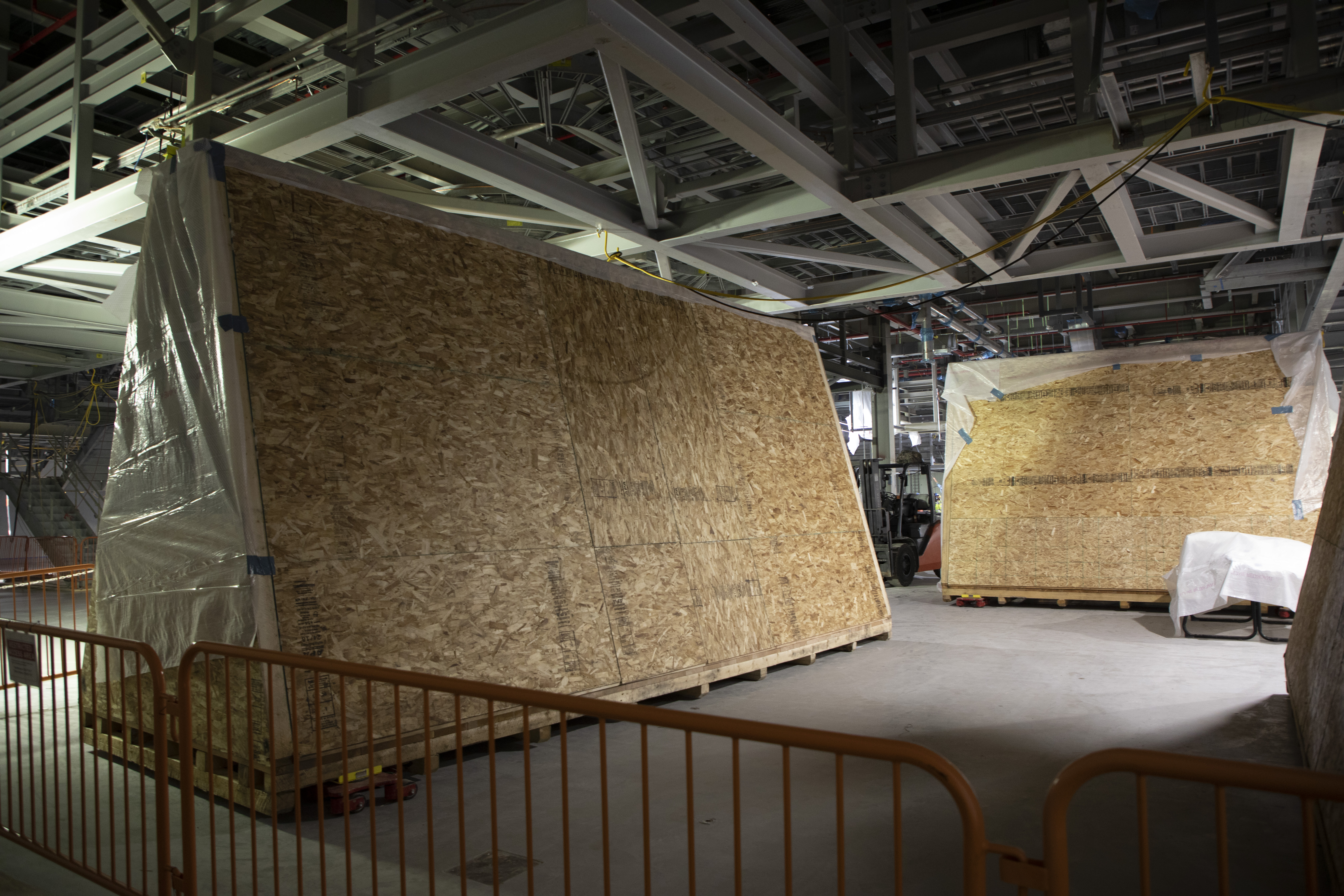
Shipping crates of the Main Casting Glovebox Line, Group 1 in MPB East
When building the Uranium Processing Facility (UPF), the option for free, two-day shipping is seldom, if ever, an option. Many items that are ordered for the project are so specialized that it takes months – or years – to see their arrival. So when the UPF Project recently received 16 truckloads of shipping crates, the team was excited and proud to receive the heart of the Main Process Building (MPB)…gloveboxes!
This shipment of gloveboxes included the Tool Preparation and Storage section, the first of five groups of the UPF Main Casting Glovebox Line. Many of the crates were so large that they had to be opened or adjusted to fit through the 20-ft.-tall doorways of the MPB. But once inside, they fit like a glove.
Currently, group one is being installed on the first floor of MPB East and is scheduled for completion by the end of August 2021. The MPB is the last of seven UPF subprojects and, once completed, will include 242,000 square feet of casting, special oxide, and some chemical recovery processes. The main processing work will take place on the first two levels with the third floor containing support utilities.
“Thank you to our Glovebox Delivery Center teammates, Engineering, Procurement, Construction, and many others who were involved in this effort,” said Dena Volovar, UPF Project Director. “The team worked together during supplier production, COVID-19 delays, and through some challenging logistics to get us to where we are today.”
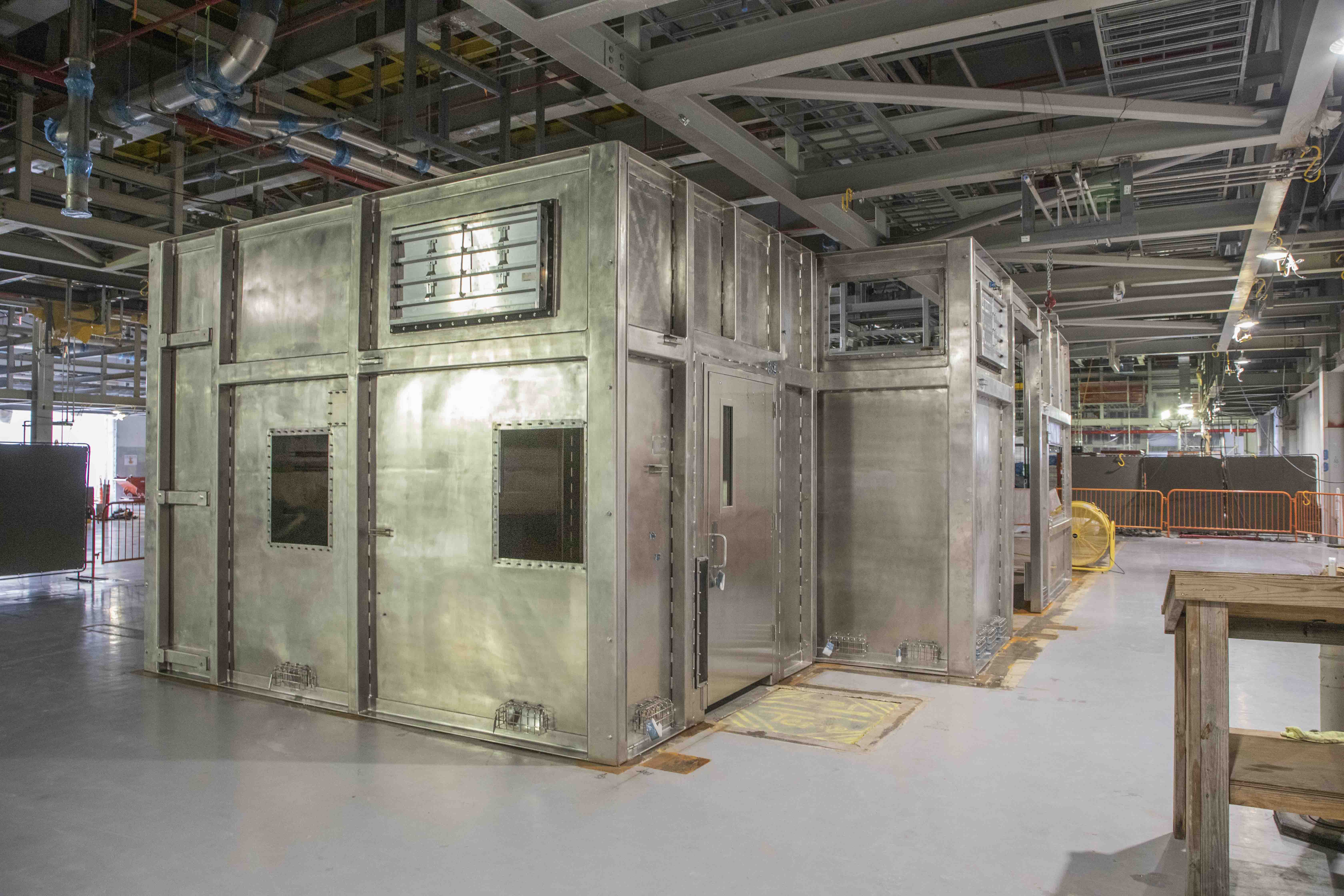
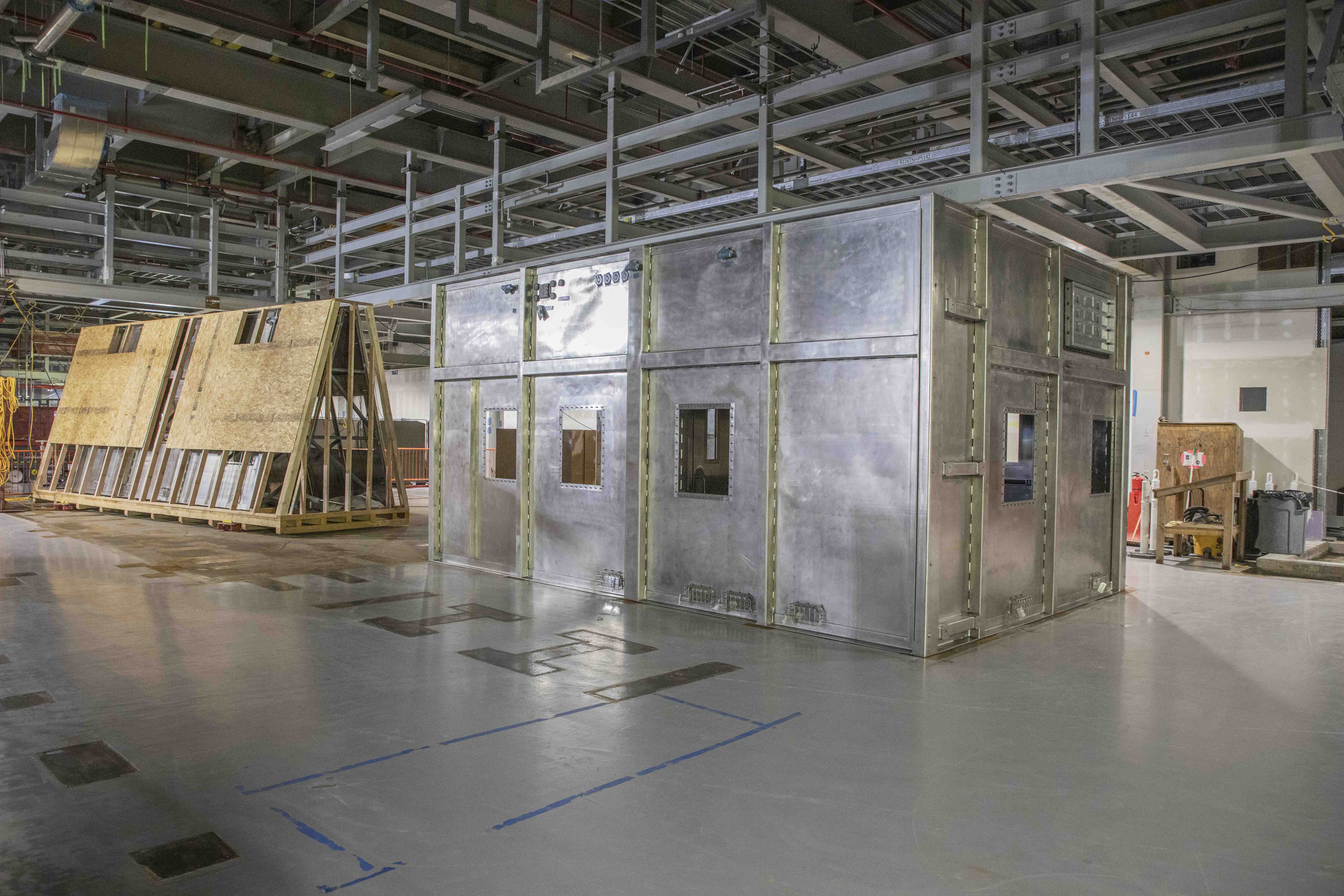
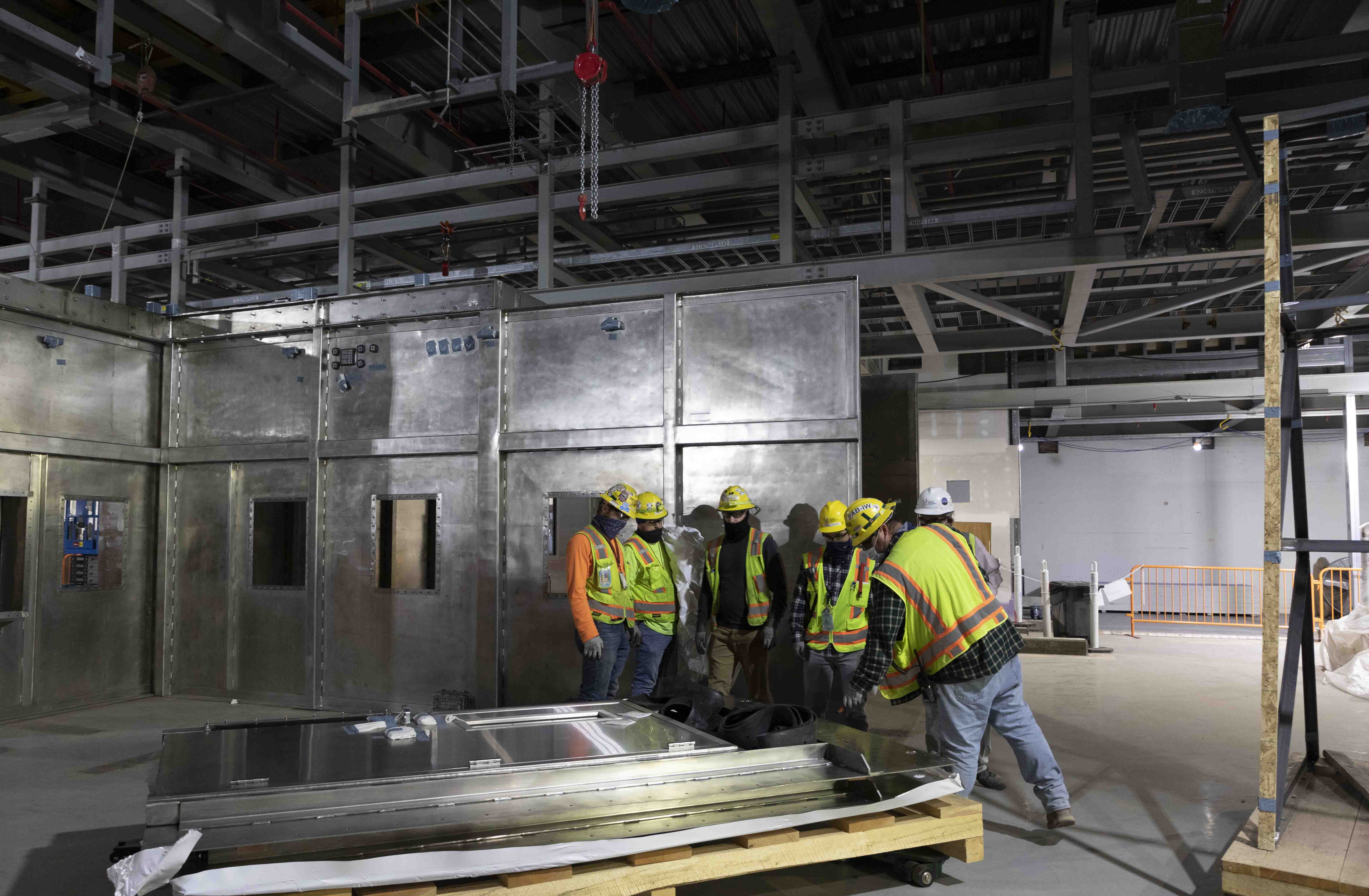
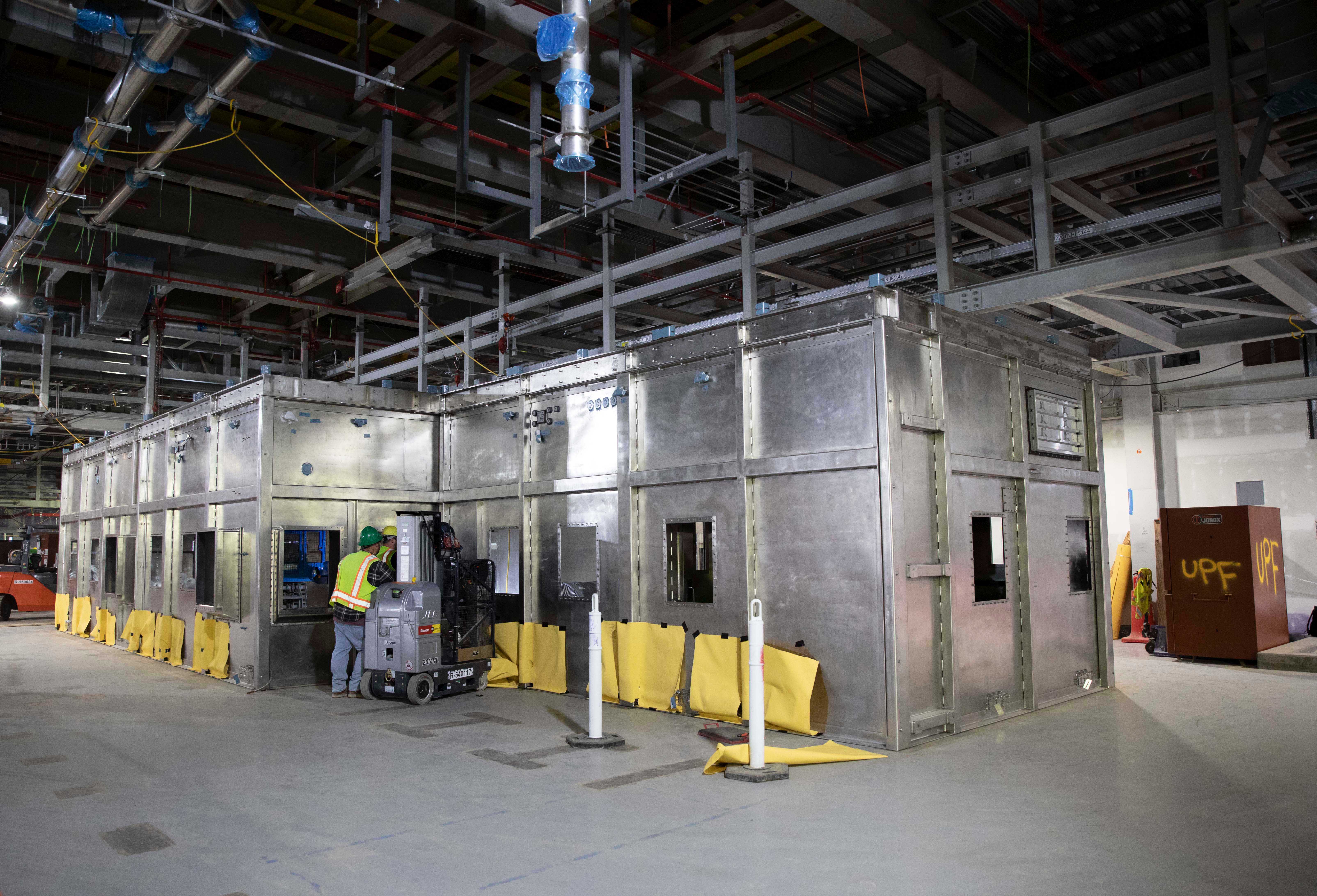

UPF Electrician inspects wiring in the 13.8kV switchgear (Per work assessment and STAART card requirements gloves are not required during the activities pictured)
Transformers are humming at the Uranium Processing Facility (UPF) as the project successfully energized medium voltage power to the Mechanical Electrical Building (MEB) during the month of June. This energization was the first connection to the Pine Ridge Substation, which the project completed in December 2019, and represents permanent power to the site.
The MEB plays the vital role of distributing power to the UPF Project. With project equipment previously running on temporary construction power, the achievement of this energization marks another step towards system operations as the MEB continues to finalize construction and progress through its testing and start-up phase.
“This energization required months of coordination between multiple entities, which included BNI Startup, BNI Engineering, CNS AHJs (authority having jurisdiction), CNS Power Operations, Subcontractors and numerous others,” said Jeremy Wilkins, UPF Start-Up Manager. “The UPF project team put in countless hours demonstrating the dedication and quality of work needed to successfully achieve this significant project milestone. It was a job well done and most importantly, it was a job done safely,”
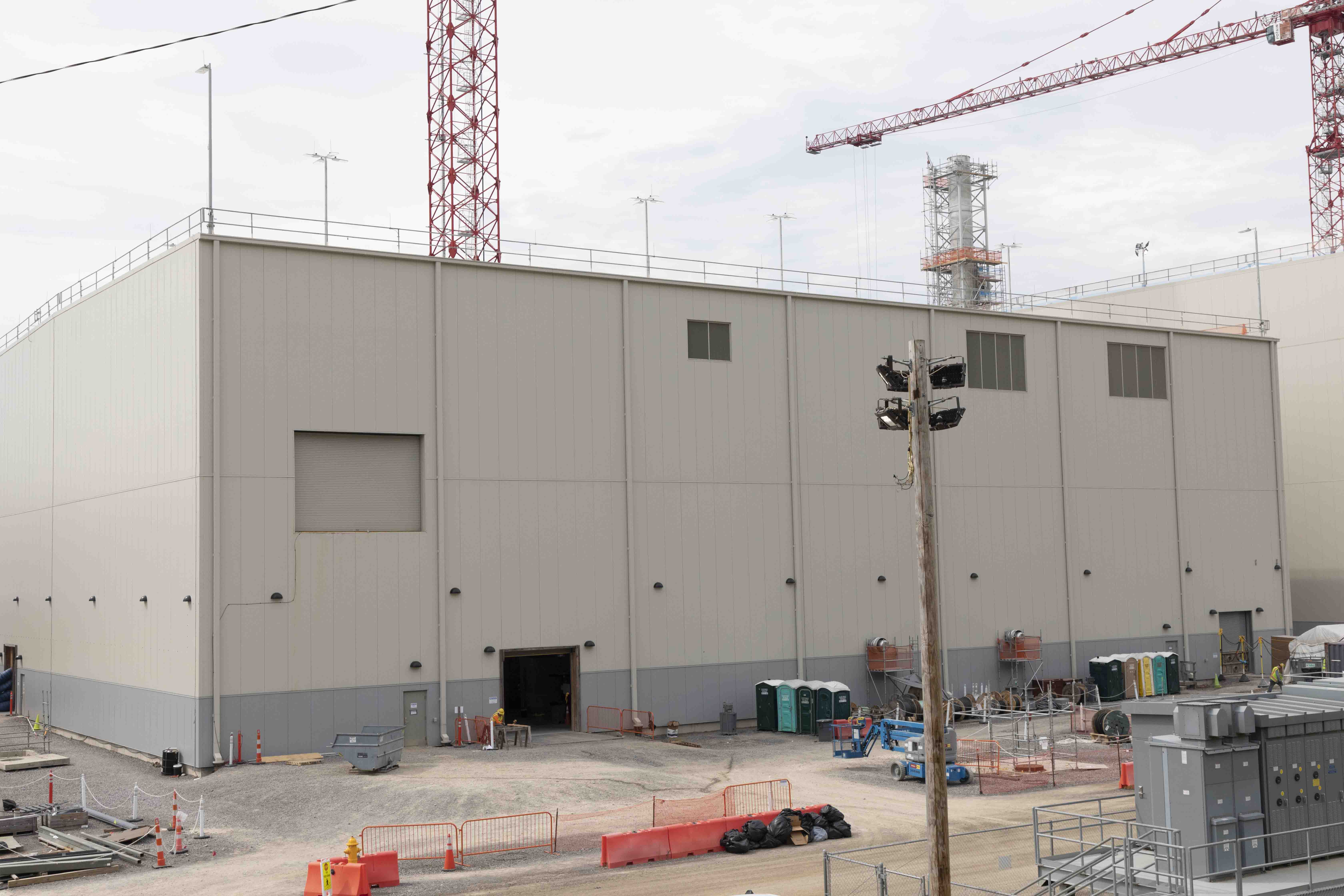
The UPF Project successfully energized Medium Voltage Power in the Mechanical Electrical Building
“Thank you to all of our team members who made this happen. We have come a long way from what once started as a parking lot and that is solely because of every individual’s efforts on the UPF Project,” said Dena Volovar, UPF Project Director.
As the project progresses, the medium voltage power system will supply power to both the process and utility systems in the MEB, as well providing power to the other UPF buildings such as the Main Process Building and the Salvage and Accountability Building.
